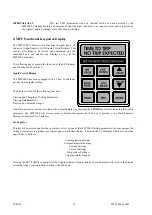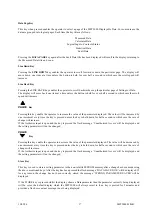
15/05/96
25
MPC2000 01/96B
9.5. Temperature Settings
RTD/Thermistor
This setting range: 'RTD' or 'Thermistor', with a default setting of 'RTD', determines whether Resistance Temperature
Detectors or Thermistors are being used for temperature monitoring. In addition to this setting a change in the setting
of an internal group of dip switches is required, refer to notes given in the MPC Measured Inputs section.
Thermistor Type
This setting, range PTC or NTC is only applicable if Thermistor is set above. It determines whether positive or
negative coefficient Thermistors are being used.
Channel 1 Alarm
This setting, range 100-30,000 Ohms if Thermistors are selected and range 100-240 ohms if RTD is selected determines
the resistance level at which an alarm will occur.
Channel 2 Alarm
This setting, range 100-30,000 Ohms if Thermis tors are selected and range 100-240 ohms if RTD is selected determines
the resistance level at which an alarm will occur.
Channel 3 Alarm
This setting, range 100-30,000 Ohms if Thermistors are selected and range 100-240 ohms if RTD is selected determines
the resistance level at which an alarm will occur.
Channel 1 Trip
This setting, range 100-30,000 Ohms if Thermistors are selected and range 100-240 ohms if RTD is selected determines
the resistance level at which an trip will occur.
Channel 2 Trip
This setting, range 100-30,000 Ohms if Thermistors are selected and range 100-240 ohms if RTD is selected determines
the resistance level at which an trip will occur.
Channel 3 Trip
This setting, range 100-30,000 Ohms if Thermistors are selected and ranxge 100-240 ohms if RTD is selected determines
the resistance level at which an trip will occur.
The above settings are adjustable in steps 100 Ohms for Thermistors and 1 Ohm for RTD's.
9.6. Tripping/Alarm Options
This page contains the following settings for each protective function incorporated in the MPC2000.
Trip
This setting range 'Enable' or 'Disable' determines whether operation of the protective function causes a trip to the
motor or not. This can be applied to an alarm such that an alarm can be made to give a trip.
Alarm
The option, 'Enable' or 'Disable' determines whether the protective functions cause an alarm to occur and is applicable
to both alarm and trip protective functions.
Auto Reset
The option 'Enable or 'Disable' allows self resetting of a fault or alarm once the fault is no longer present. In the case of
Thermal Overload or Too Many Starts faults the self reset will not occur until the capacity has cooled to 50% or the
Starts inhibit period has passed.
Panel Reset






























